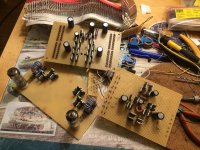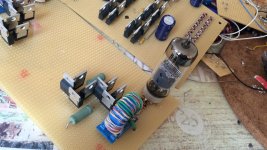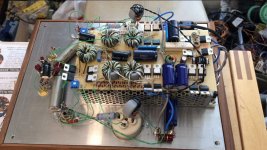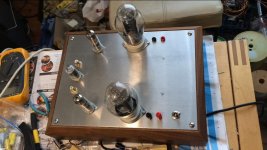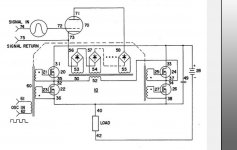Are you familiar with the book Hi-Fi Amplifier Circuits by E. Rodenhuis?
People should read this.Very usefull information.
People should read this.Very usefull information.
Most surprisingly to me, Thorsten`s design contains no dirty elements.
can you please elaborate what lacking "dirty elements" actually meant in Thorstein's designs...
He was a banned member here long time ago.....i remember his animated debates with SY that time...the push pull versus single ended debates...
has since then waned a lot...
Last edited:
In my capacity as a purist, I regard active devices such as gyrators, voltage regulators, voltage sources, current sources, current mirrors, ICs, diodes, also plate inductors as dirty parts that do not belong in an audio amplifier but are carried in from industrial applications and can be replaced with a resistor for lowest distortion.
Am I too rigorous?
Am I too rigorous?
In my capacity as a purist, I regard active devices such as gyrators, voltage regulators, voltage sources, current sources, current mirrors, ICs, diodes, also plate inductors as dirty parts that do not belong in an audio amplifier but are carried in from industrial applications and can be replaced with a resistor for lowest distortion.
Am I too rigorous?
not at all, you can do as you like with your own amp, and you can even share here, but if you go around telling others that they should follow your lead, then that is where problems begin.....
hey, this is DIY and members are allowed to think outside the box and do crazy things as long as they do not get electrocuted,
i like technical debates, but at the end of the day, i will do what i believe is right to do in my build, my amps, but i will respect people having contrary views although i may not agree with their beliefs....
Opinions are communicated in a take it or leave it manner, right?
Lampie519
that`s increased efficiency, power handling and driving ability. I had qualitative performance in mind. Do you really think that higher gain gives lower distortion?
I know many inventions that improved performance that are not very old (Allen Wright's cathode follower, David Berning's Zotl, John Strickland's Transnova and HV OTL's just to name a few). Many here like the Mu Follower and that is not so old either. PPP amps and OTL's like the Tim Mellows version or Atmasphere. I can go on and on....
Try John Broskie's website or Steve Bench...
Lampie519
that`s increased efficiency, power handling and driving ability. I had qualitative performance in mind. Do you really think that higher gain gives lower distortion?
I think so.In my capacity as a purist, I regard active devices such as gyrators, voltage regulators, voltage sources, current sources, current mirrors, ICs, diodes, also plate inductors as dirty parts that do not belong in an audio amplifier but are carried in from industrial applications and can be replaced with a resistor for lowest distortion.
Am I too rigorous?
With constant current sources/sinks its possible to get a horizontal loadline, which minimizes distortions, compared to a resistor loadline.
Former generations of tube designers used coils for that purpose.
And a good regulated PSU is very easy to design, but it takes much effort to achieve the same low ripple output voltages with a discrete/passive PSU.
The drawbacks I see are that we are talking about active devices vs. passive.
A CCS or a regulated PSU are active devices, and they need time to regulate the signal, so they are slower. Its the typical response time for an active device.
That is audible in some cases.
I don't want to employ active regulator devices, too and do think that true tube sound is only achievable with passive parts. But that is open for discussion and a wide field of discussion about this topic will follow soon regarding the pro/cons of horizontal loadlines vs. system response lags of active devices like CCS.
Last edited:
Opinions are communicated in a take it or leave it manner, right?
yes, no need to get emotional at all...
Lampie519
that`s increased efficiency, power handling and driving ability. I had qualitative performance in mind. Do you really think that higher gain gives lower distortion?
only if you are using global negative feedback, higher open loop gains not exceeding 56db, is fine with application of loop feedback..
for singe ended tube amps, no need to go high...as most of the time gain is low enough to begin with...
My finding is that replacing all passive components with active ones will improve performance and linearity of any amp a lot. The amp will be able to drive complex loads like screen grids and will drive any output tube into class A2. Yes, you can call this efficiency but it also sound better to me (opinion) as the system becomes more dynamic and reveals more micro information.
In my capacity as a purist, I regard active devices such as gyrators, voltage regulators, voltage sources, current sources, current mirrors, ICs, diodes, also plate inductors as dirty parts that do not belong in an audio amplifier but are carried in from industrial applications and can be replaced with a resistor for lowest distortion.
Am I too rigorous?
Not necessarily "dirty", they have specific timbres. If you have a flexible mind, you can work around their signature. For example you can make your CCS sound different by the choice of mounting, heatsink, wiring material, solder, etc. You can always get around the timbre of components.
That gives you flexibility. Otherwise you start being a typical "mantra audiophile", often throwing around your own religious thinking of your own perception of "truth". The audiophile world is quite full of these colors of "truth". The important detail is remember here - religious thinking is the enemy of flexibility and IMHO, the enemy of good sound reproduction.
Last edited:
A religion always is based on beliefs, audio should be based on experience and opportunities.
But what if someone has listened to the great audio concepts of the past and likes those. They never used this modern active devices.
So if one shows a clear preference for those designs and therefore cancel the active devices out for his DIY, won't that sound like the typical mantra audiophile, too? Just because someone has ceased using those parts and choosing to build other concepts?
I think this could be applied to your assignation of a mantra audiophile, although its not true in this case.
Just experience in a long audio hobby life, that leads to the preference of specific concepts.
But what if someone has listened to the great audio concepts of the past and likes those. They never used this modern active devices.
So if one shows a clear preference for those designs and therefore cancel the active devices out for his DIY, won't that sound like the typical mantra audiophile, too? Just because someone has ceased using those parts and choosing to build other concepts?
I think this could be applied to your assignation of a mantra audiophile, although its not true in this case.
Just experience in a long audio hobby life, that leads to the preference of specific concepts.
Depends on how good those are being designed and applied.My finding is that replacing all passive components with active ones will improve performance and linearity of any amp a lot. The amp will be able to drive complex loads like screen grids and will drive any output tube into class A2. Yes, you can call this efficiency but it also sound better to me (opinion) as the system becomes more dynamic and reveals more micro information.
I know of some amps that would sound better without, because every active regulation device is slow compared to passive devices, because a regulation uses a closed loop with negative feedback to regulate. This could make an amp sound slooooowwwww.
<snip>
Just experience in a long audio hobby life, that leads to the preference of specific concepts.
Interesting, I've found quite the reverse, but everyone is different in how they view these things.
I guess I devolved, I went from early on having very specific preferences and a very orthodox approach to design, to throwing out all of my conceptions/pre-conceptions and trying a lot of new ideas.
My original perceptions centered around pure tube electronics with either direct or RC coupling, pushpull output stages and tube rectification with conventional pi-filtering. I did some good designs which were locally popular. My pre-amplifiers did feature tube based voltage regulators, and DC on the filaments, but at least initially were pretty orthodox.
I dismissed pretty much anything that was not regarded as standard engineering practice at the end of the tube era - which occurred in my childhood.
The world around me changed and as I got older I became more flexible. Longer ago than I care to admit I designed and built my first SE amplifier, a design based around the 45 with a 6SL7 SRPP as the driver stage, and no global feedback. Power was provided by a primitive set of tube based voltage regulators. I expected it to suck, it didn't, 25 years later it's still in use - now with a friend.
There have been a long progression of evolving RC, IT coupled and hybrid DHT SE power amps since. All have in some way improved over what preceded them.
I mixed cascode mosfets with high transconductance Russian VHF triodes in some of my phono stages starting about 8 - 9 years ago - big improvement over my older designs, enough so that one of those designs is licensed for commercial production. (Hopefully it will be out next year)
I have done worse things, designed solid state line level crossovers using <horrors> jfet opamps..
The current system is active, has 4 channels running hybrid DHT SE amps and 2 channels with IT drive - all solid state power supplies. Transformer output DHT pre-amp, solid state XO and horrors DSP.. Everything on balanced IO. Speakers are over 100dB/Spl @ 1w, system is dead silent - wish I could say the same for a few of the power transformers.. LOL (magnetostriction noise in the cores)
Onken type bass bins, and horn based mids and highs. Ouch! (I spent 30 years thinking this was obsolete technology before even trying it.)
My younger self would have been horrified at the many heresies this system contains, the older self smiles for about 30 hours a week listening to it, because it is clearly my best work.
As I have gotten older I have come to understand that quality of implementation counts for a lot, no it's not perfect, but modern technology makes lots of interesting options available for pursuit. I enjoy the adventure - this is the best time ever to be in this hobby, the options are almost endless.
I have only one interest and that is the personal pursuit of what I perceive to be better sound. My system is quite complex and not for everyone I'd guess. My taste in music spans a wide range from techno to rock/pop to jazz to chamber orchestra to symphonic music, so the goal is neutrality so that all music is well served. No disrespect intended to anyone. 😀
Something to note is that I don't use many conventional "audio" tubes in my designs - this has allowed me largely to circumvent the problems with modern tube production. And those late to the game tubes offer all sorts of interesting performance possibilities unachievable with garden variety hifi tubes.
Trying new things and not getting stuck to the things we already know is like an adventure. So even not all new designs are directly a success it can still provide some new insight and equired knowledge. So if you only discuss topology without building anything new you will not be able to reach your goal (this is different for everyone here i guess).
Some maybe know that i am a big fan of Zotl technology and i have build many amps using this technology including a SE 300b amp. This is the cleanest 300b amp i have heard so far plus it has the most accurate bass response of any SE amp out there (theoretically down to DC).
My new project includes this technology as well even in the driver stage. In this way i do not even need any HV power supply.
People claim to be purist but never heard a 300b in its purest form.
If you are interested then try to audition the Siegfried 300B or build one yourself as this is the DiY-audio forum isn't it?
Some maybe know that i am a big fan of Zotl technology and i have build many amps using this technology including a SE 300b amp. This is the cleanest 300b amp i have heard so far plus it has the most accurate bass response of any SE amp out there (theoretically down to DC).
My new project includes this technology as well even in the driver stage. In this way i do not even need any HV power supply.
People claim to be purist but never heard a 300b in its purest form.
If you are interested then try to audition the Siegfried 300B or build one yourself as this is the DiY-audio forum isn't it?
Attachments
Some maybe know that i am a big fan of Zotl technology and i have build many amps using this technology including a SE 300b amp. This is the cleanest 300b amp i have heard so far plus it has the most accurate bass response of any SE amp out there (theoretically down to DC). My new project includes this technology as well even in the driver stage. In this way i do not even need any HV power supply. People claim to be purist but never heard a 300b in its purest form. If you are interested then try to audition the Siegfried 300B or build one yourself as this is the DiY-audio forum isn't it?
Tube amplifiers for high-end audio by The David Berning Company
I had to look up David Berning's Siegfried. Very different. Don't know what Zoti technology is, though.
Zero Hysteresis Output transformer less.
Please understand that this is not an OTL as such but it behaves like one.
The impedance converter is a HF circuit that converts low voltage to the needed high voltage for the tubes and at the same time will convert the LF audio from the tube (Class A or B whatever you desire) back to the low voltage side and to the load.
Please understand that this is not an OTL as such but it behaves like one.
The impedance converter is a HF circuit that converts low voltage to the needed high voltage for the tubes and at the same time will convert the LF audio from the tube (Class A or B whatever you desire) back to the low voltage side and to the load.
Attachments
Schmitz77, wie geht's?
OK, I have a lot to say, but I am only able to compose three sentences at a time. More detailed explanations could reduce misunderstanding.
Another enemy is the nasty switching distortion produced by rectifying diodes. There is not much talk about the issue. It turns out that switching transients are extremely hard to deal with, voltage regulators are useless for the task, only creating more distortion. Chokes operate in an entirely different way, however, in the case of CLC filter, the charging process still consists of short, energetic, poorly damped pulses. An LC filter is preferable, but trickier to implement.
OK, I have a lot to say, but I am only able to compose three sentences at a time. More detailed explanations could reduce misunderstanding.
Another enemy is the nasty switching distortion produced by rectifying diodes. There is not much talk about the issue. It turns out that switching transients are extremely hard to deal with, voltage regulators are useless for the task, only creating more distortion. Chokes operate in an entirely different way, however, in the case of CLC filter, the charging process still consists of short, energetic, poorly damped pulses. An LC filter is preferable, but trickier to implement.
- Home
- Amplifiers
- Tubes / Valves
- 300b with single stage driver, C3M or?
